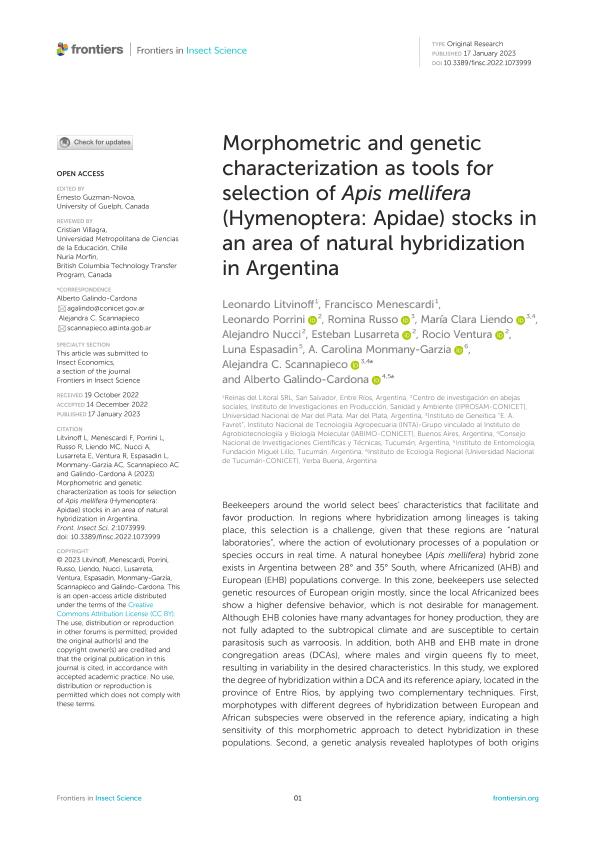Mostrar el registro sencillo del ítem
dc.contributor.author
Litvinoff, Leonardo
dc.contributor.author
Menescardi, Francisco
dc.contributor.author
Porrini, Leonardo Pablo

dc.contributor.author
Russo, Romina
dc.contributor.author
Liendo, María Clara

dc.contributor.author
Nucci, Alejandro
dc.contributor.author
Lusarreta, Esteban
dc.contributor.author
Ventura, Rocía
dc.contributor.author
Espasadin, Luna
dc.contributor.author
Monmany, Ana Carolina

dc.contributor.author
Scannapieco, Alejandra Carla

dc.contributor.author
Galindo Cardona, Alberto

dc.date.available
2024-02-26T13:35:59Z
dc.date.issued
2023-01
dc.identifier.citation
Litvinoff, Leonardo; Menescardi, Francisco ; Porrini, Leonardo Pablo; Russo, Romina; Liendo, María Clara; et al.; Morphometric and genetic characterization as tools for selection of Apis mellifera (Hymenoptera: Apidae) stocks in an area of natural hybridization in Argentina; Frontiers Media; Frontiers in Insect Science; 2; 1-2023; 1-10
dc.identifier.uri
http://hdl.handle.net/11336/228394
dc.description.abstract
Beekeepers around the world select bees’ characteristics that facilitate and favor production. In regions where hybridization among lineages is taking place, this selection is a challenge, given that these regions are “natural laboratories”, where the action of evolutionary processes of a population or species occurs in real time. A natural honeybee (Apis mellifera) hybrid zone exists in Argentina between 28° and 35° South, where Africanized (AHB) and European (EHB) populations converge. In this zone, beekeepers use selected genetic resources of European origin mostly, since the local Africanized bees show a higher defensive behavior, which is not desirable for management. Although EHB colonies have many advantages for honey production, they are not fully adapted to the subtropical climate and are susceptible to certain parasitosis such as varroosis. In addition, both AHB and EHB mate in drone congregation areas (DCAs), where males and virgin queens fly to meet, resulting in variability in the desired characteristics. In this study, we explored the degree of hybridization within a DCA and its reference apiary, located in the province of Entre Ríos, by applying two complementary techniques. First, morphotypes with different degrees of hybridization between European and African subspecies were observed in the reference apiary, indicating a high sensitivity of this morphometric approach to detect hybridization in these populations. Second, a genetic analysis revealed haplotypes of both origins for drones in DCAs, with a higher prevalence of European haplotypes, while all the colonies from the reference apiary exhibited European haplotypes. Overall, our results are in line with the strong impact that commercial beekeeping has on the genetics of DCAs. We show how wing morphometry may be used to monitor hybridization between European and African subspecies, a tool that may be evaluated in other regions of the world where hybridization occurs.
dc.format
application/pdf
dc.language.iso
eng
dc.publisher
Frontiers Media

dc.rights
info:eu-repo/semantics/openAccess
dc.rights.uri
https://creativecommons.org/licenses/by-nc-sa/2.5/ar/
dc.subject
AFRICANIZATION
dc.subject
DRONE CONGREGATION AREAS
dc.subject
HONEY BEES
dc.subject
HYBRID ZONE
dc.subject
MATING
dc.subject.classification
Otras Producción Animal y Lechería

dc.subject.classification
Producción Animal y Lechería

dc.subject.classification
CIENCIAS AGRÍCOLAS

dc.title
Morphometric and genetic characterization as tools for selection of Apis mellifera (Hymenoptera: Apidae) stocks in an area of natural hybridization in Argentina
dc.type
info:eu-repo/semantics/article
dc.type
info:ar-repo/semantics/artículo
dc.type
info:eu-repo/semantics/publishedVersion
dc.date.updated
2024-01-18T14:19:22Z
dc.identifier.eissn
2673-8600
dc.journal.volume
2
dc.journal.pagination
1-10
dc.journal.pais
Suiza

dc.description.fil
Fil: Litvinoff, Leonardo. Reinas del Litoral Srl; Argentina
dc.description.fil
Fil: Menescardi, Francisco. Reinas del Litoral Srl; Argentina
dc.description.fil
Fil: Porrini, Leonardo Pablo. Universidad Nacional de Mar del Plata. Instituto de Investigaciones En Produccion, Sanidad y Ambiente. - Consejo Nacional de Investigaciones Cientificas y Tecnicas. Centro Cientifico Tecnologico Conicet - Mar del Plata. Instituto de Investigaciones En Produccion, Sanidad y Ambiente.; Argentina
dc.description.fil
Fil: Russo, Romina. Instituto Nacional de Tecnologia Agropecuaria. Centro de Investigacion En Ciencias Veterinarias y Agronomicas. Instituto de Agrobiotecnologia y Biologia Molecular. Grupo Vinculado Instituto de Genetica "ewald A. Favret" Al Iabimo | Consejo Nacional de Investigaciones Cientificas y Tecnicas. Oficina de Coordinacion Administrativa Pque. Centenario. Instituto de Agrobiotecnologia y Biologia Molecular. Grupo Vinculado Instituto de Genetica "ewald A. Favret" Al Iabimo.; Argentina
dc.description.fil
Fil: Liendo, María Clara. Instituto Nacional de Tecnologia Agropecuaria. Centro de Investigacion En Ciencias Veterinarias y Agronomicas. Instituto de Agrobiotecnologia y Biologia Molecular. Grupo Vinculado Instituto de Genetica "ewald A. Favret" Al Iabimo | Consejo Nacional de Investigaciones Cientificas y Tecnicas. Oficina de Coordinacion Administrativa Pque. Centenario. Instituto de Agrobiotecnologia y Biologia Molecular. Grupo Vinculado Instituto de Genetica "ewald A. Favret" Al Iabimo.; Argentina
dc.description.fil
Fil: Nucci, Alejandro. Universidad Nacional de Mar del Plata. Instituto de Investigaciones En Produccion, Sanidad y Ambiente. - Consejo Nacional de Investigaciones Cientificas y Tecnicas. Centro Cientifico Tecnologico Conicet - Mar del Plata. Instituto de Investigaciones En Produccion, Sanidad y Ambiente.; Argentina
dc.description.fil
Fil: Lusarreta, Esteban. Universidad Nacional de Mar del Plata. Instituto de Investigaciones En Produccion, Sanidad y Ambiente. - Consejo Nacional de Investigaciones Cientificas y Tecnicas. Centro Cientifico Tecnologico Conicet - Mar del Plata. Instituto de Investigaciones En Produccion, Sanidad y Ambiente.; Argentina
dc.description.fil
Fil: Ventura, Rocía. Universidad Nacional de Mar del Plata. Instituto de Investigaciones En Produccion, Sanidad y Ambiente. - Consejo Nacional de Investigaciones Cientificas y Tecnicas. Centro Cientifico Tecnologico Conicet - Mar del Plata. Instituto de Investigaciones En Produccion, Sanidad y Ambiente.; Argentina
dc.description.fil
Fil: Espasadin, Luna. Fundación Miguel Lillo; Argentina
dc.description.fil
Fil: Monmany, Ana Carolina. Universidad Nacional de Tucumán. Instituto de Ecología Regional. Consejo Nacional de Investigaciones Científicas y Técnicas. Centro Científico Tecnológico Conicet - Tucumán. Instituto de Ecología Regional; Argentina
dc.description.fil
Fil: Scannapieco, Alejandra Carla. Instituto Nacional de Tecnologia Agropecuaria. Centro de Investigacion En Ciencias Veterinarias y Agronomicas. Instituto de Agrobiotecnologia y Biologia Molecular. Grupo Vinculado Instituto de Genetica "ewald A. Favret" Al Iabimo | Consejo Nacional de Investigaciones Cientificas y Tecnicas. Oficina de Coordinacion Administrativa Pque. Centenario. Instituto de Agrobiotecnologia y Biologia Molecular. Grupo Vinculado Instituto de Genetica "ewald A. Favret" Al Iabimo.; Argentina
dc.description.fil
Fil: Galindo Cardona, Alberto. Consejo Nacional de Investigaciones Científicas y Técnicas. Centro Científico Tecnológico Conicet - Tucumán; Argentina
dc.journal.title
Frontiers in Insect Science
dc.relation.alternativeid
info:eu-repo/semantics/altIdentifier/url/https://www.frontiersin.org/articles/10.3389/finsc.2022.1073999/full
dc.relation.alternativeid
info:eu-repo/semantics/altIdentifier/doi/http://dx.doi.org/10.3389/finsc.2022.1073999
Archivos asociados
